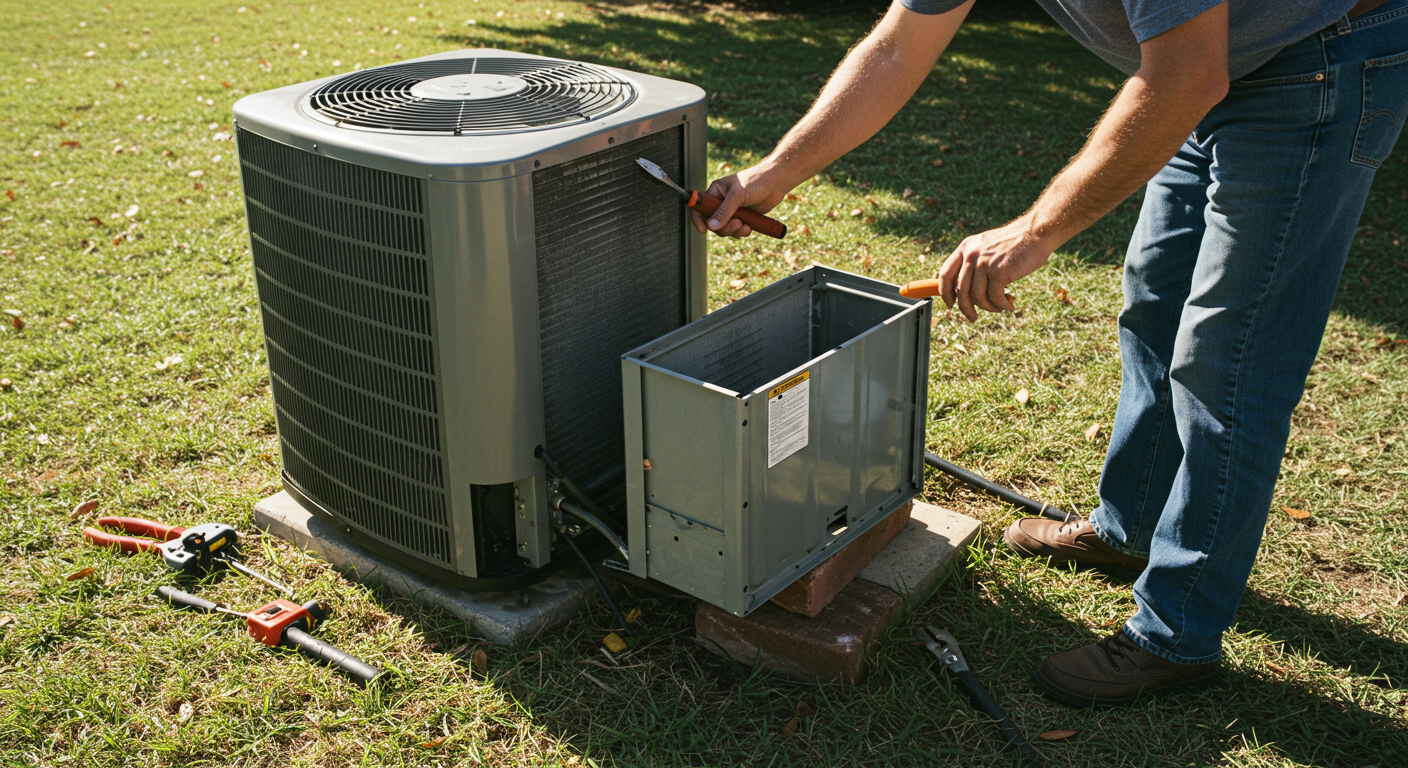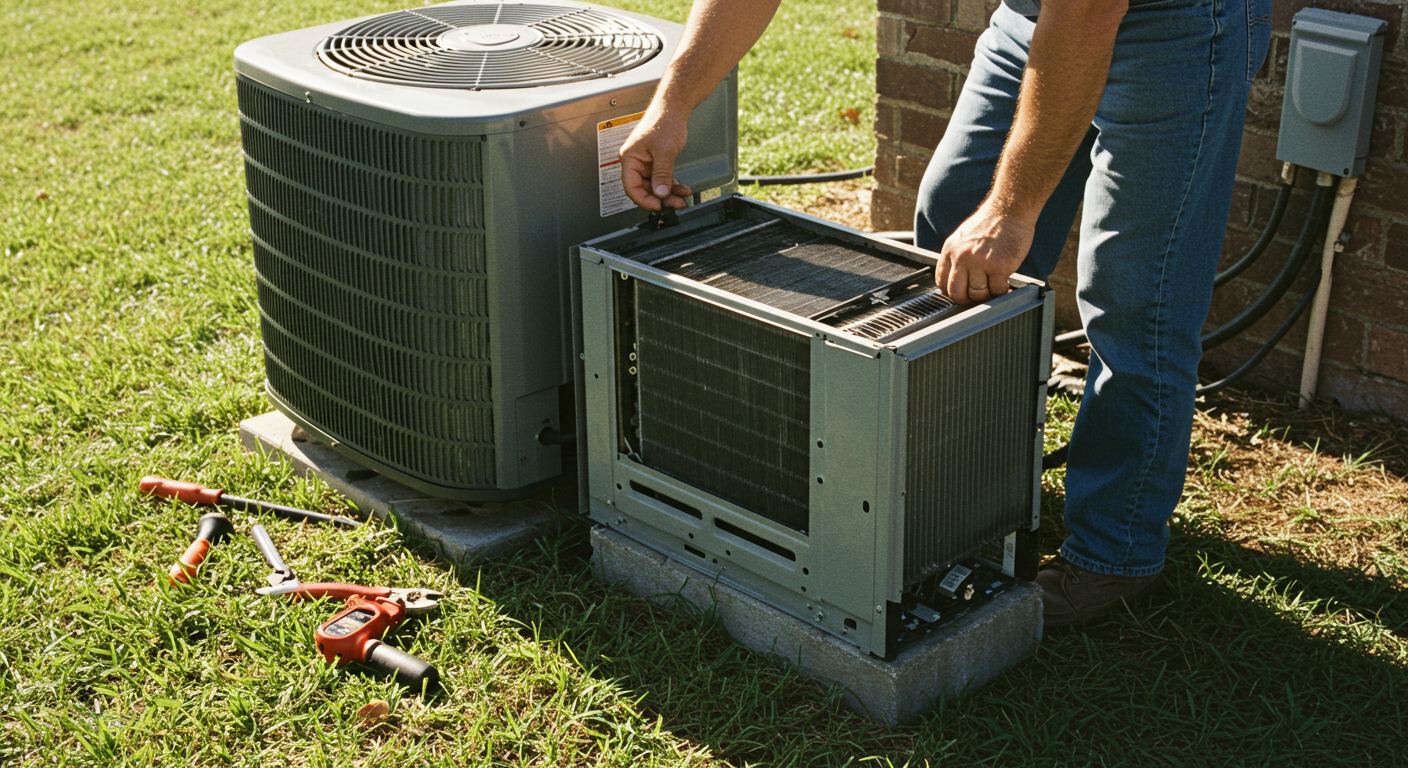In Texas, an air conditioner isn’t just a comfort; it’s a necessity. When the heat starts pushing past 100 degrees in places like Dallas, Houston, Austin, and San Antonio, a faulty cooling system can quickly turn a normal day into a miserable one. That’s why understanding common air conditioner issues and knowing how to troubleshoot them is so important for homeowners here.
At Shellaby A/C & Refrigeration, we often get calls from people saying, “What’s wrong with my AC?” or “It’s running, but it’s not cooling.” The truth is, there are a handful of problems that show up again and again in Texas homes. Some can be fixed with a quick adjustment, while others need professional repair.
Below, we’ll walk through the most common problems with air conditioning units, why they happen, and the steps you can take to fix them or at least prevent them from getting worse.

1. AC Blowing Warm Air
When your air conditioner is running but you still feel warm air coming from the vents, it’s usually a sign that something’s off with airflow, refrigerant, or the thermostat.
This often happens when the air filter is clogged with dust and debris, which restricts airflow and makes the system overheat. It can also be caused by a frozen evaporator coil or low refrigerant levels.
What to try first:
Check your thermostat and make sure it’s set to “cool” and a few degrees lower than the current room temperature. If that’s fine, look at the air filter. If it’s dirty, replace it immediately, especially in Texas, where dust and pollen can clog filters faster than in other states.
If the outdoor condenser unit is covered in leaves, grass, or dirt, gently clear the area so it can breathe.
If none of these help, the problem may be a refrigerant leak or frozen coil, which means it’s time to call a professional.
2. AC Running But House Still Feels Hot
Sometimes the unit runs for hours, but never cools the house to the temperature you set. This is one of the most common home air conditioner problems during Texas heat waves.
This can happen if the condenser coils outside are dirty, your ductwork has leaks, or your attic insulation isn’t keeping the cool air in.
Steps you can take:
Rinse the outdoor condenser coils with a garden hose, spraying gently from the top down to avoid bending the fins. Check your air ducts for visible gaps and seal them with foil tape or mastic. If your attic insulation looks thin or patchy, adding more can make a big difference in keeping cool air inside.
If the compressor is failing, you’ll notice the AC running but with weak cooling power. That’s a major repair and should be handled by a licensed technician.
3. AC Won’t Turn On
It’s frustrating when the AC doesn’t start at all, especially when the Texas sun is already baking the house.
The first place to check is your electrical panel. If the breaker for the AC has tripped, flip it back on. If it trips again, there may be a wiring or component problem that needs professional attention.
Thermostat batteries are another simple fix. If they’re dead, the AC won’t start because it’s not getting the signal to turn on.
Sometimes the issue is a blown fuse in the outdoor disconnect box or a failed capacitor. Capacitors are among the most common AC parts that fail and should only be replaced by someone who knows how to work safely with electrical components.
4. Weak Airflow From Vents
When cool air trickles out of your vents instead of blowing strongly, there’s usually a blockage or mechanical failure somewhere in the system.
The first step is to check your vents and make sure none are closed or blocked by furniture, rugs, or curtains. Then, inspect your air filter; if it’s clogged, replace it.
If that doesn’t help, the blower motor might be struggling. This is another one of the common air conditioner repairs we handle regularly. A failing blower motor means your system can’t push enough air through the ducts, which makes cooling inefficient and uneven.
5. Water Leaking Indoors
Seeing water around your indoor AC unit can be alarming. In humid Texas cities like Rockport or Corpus Christi, this often happens when the condensate drain line gets clogged with algae, dirt, or debris.
You can use a wet/dry vacuum to clear the line from the outside drain outlet. If the drain pan under your unit is rusted or cracked, it should be replaced to avoid water damage to your flooring or ceiling.
If the evaporator coil is freezing and then melting, creating excess water, that points to airflow or refrigerant issues that need professional diagnosis.

6. Strange Noises
A good AC should run quietly. If you start hearing banging, squealing, grinding, or rattling, something is wrong.
Loose fan blades, worn belts, or failing motor bearings are all possible culprits. Tightening loose screws and replacing belts can be a DIY job for some homeowners, but motor repairs should be left to a technician to prevent further damage.
7. Unpleasant Smells From the Vents
A musty smell often means mold or mildew inside the ductwork. This can happen in Texas homes with high humidity, especially if the AC isn’t removing enough moisture from the air.
A burning smell can be more serious, signaling an overheating motor or wiring problem. If you smell burning plastic or smoke, shut the unit off immediately and call for service.
8. AC Turns On and Off Too Often
This is called short cycling, and it’s not just annoying; it puts extra stress on the system and raises energy bills.
In many cases, short cycling is caused by an oversized AC unit that cools the house too quickly, shuts off, and then has to start again soon after. Dirty coils or low refrigerant can also be to blame.
Cleaning the coils and filters may help, but if the system is too large for your home, a professional can suggest ways to adjust its operation or recommend a better-sized unit.
9. Parts That Fail Most Often
Over the years, we’ve seen a pattern in the parts that give Texas homeowners the most trouble. Common AC parts that fail include capacitors, compressors, blower motors, contactors, and fan motors.
Many of these fail more quickly in Texas due to the prolonged, intense cooling seasons. Regular maintenance is the best way to catch wear and tear before it turns into a breakdown.
10. Preventing Problems Before They Start
The easiest way to avoid problems with AC units is to schedule preventive maintenance at least once a year. During a tune-up, a technician will check refrigerant levels, clean coils, test electrical components, and make sure airflow is strong.
Changing your air filter every one to three months, keeping the outdoor unit free of debris, and inspecting your ductwork for leaks are also important steps you can take yourself.

Why AC Issues Are More Common in Texas
Texas summers are long, hot, and humid in many areas. That means your air conditioner runs for months without much of a break. The more it runs, the faster parts wear out, refrigerant leaks develop, and coils collect dirt.
Homes in Dallas or Austin may experience more dust-related clogs, while Houston and Galveston homeowners often battle humidity-related mold and drain line issues. In smaller towns and rural areas, it’s not uncommon for ACs to work extra hard because of less shade and higher indoor heat gain.
When to Call Shellaby A/C & Refrigeration
Some repairs can be done at home, but when you’re dealing with refrigerant leaks, compressor failures, or electrical problems, it’s safer and faster to call in a professional.
Shellaby A/C & Refrigeration has been helping homeowners across Texas for over a decade. Whether you’re in Dallas, Fort Worth, Austin, Waco, or Houston, we know how to handle the common air conditioning problems that come with Texas weather. Our team can diagnose issues quickly, recommend the right fix, and get your home comfortable again.
Whether you’re dealing with weak airflow, warm air, or a unit that won’t start, Shellaby A/C & Refrigeration has seen it all and fixed it all. Call us today and enjoy a cooler, more comfortable Texas home.
